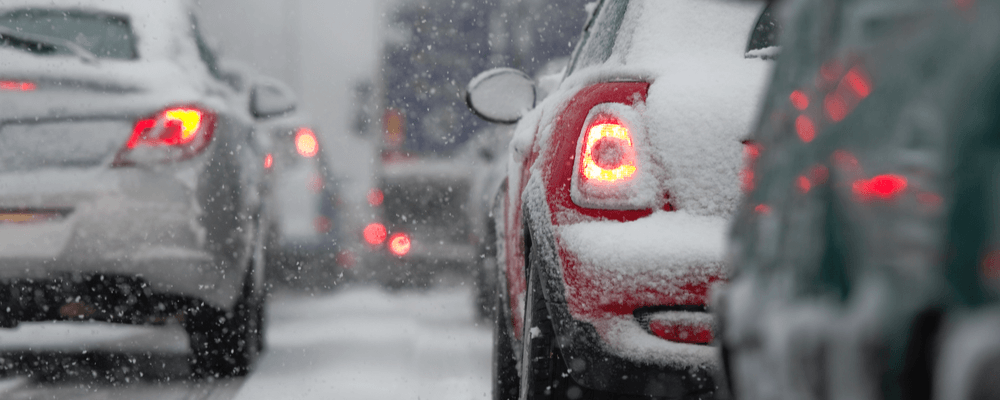
A CONCISE OVERVIEW
- Wyoming ranks number one as the worst state for fatal winter crashes
- Snow and sleet caused 13.7 percent of weather-related fatal crashes in 2018
- The 10 worst states for fatal winter crashes caused 183 fatal crashes
If you live in a state with heavy snow falls every winter, you may live in one of the most dangerous states for winter driving. Any driver who has skidded and slipped on snow and sleet before knows that weather can be the most dangerous weather to drive in.
To help drivers prepare for winter weather in their state, we’ve ranked the states with the most fatal winter crashes in America. In addition, we will cover the following topics: Winter weather crash statistics, winter roads by region, and winter driving tips from experts.
If you live in a snowy state with icy roads, make sure you read our practical guide to understanding car insurance to make sure you have the right coverages in case of a winter collision.
Ready to find out what states you need to be extra careful driving through during winter months? Read on for our complete guide to the worst states for winter driving.
Table of Contents
- Worst States for Fatal Crashes on Winter Roads
- Winter Driving Statistics Across America
- Winter Driving Safety Tips & Personal Stories
- Frequently Asked Questions: Traffic Accidents and Winter Conditions
- Methodology: Ranking the Deadliest States for Winter Driving
Worst States for Fatal Crashes on Winter Roads
To find the worst states for fatal winter crashes, our team of researchers collected 2018 crash data from the National Highway Traffic Safety Administration (NHTSA).
It is important to note that the NHTSA data is based on fatal crashes. This means each crash counted by the NHTSA was a crash that resulted in the death of at least one person, although more than one person may have died in each fatal crash.
After pulling the crash numbers for each state on weather-related crashes, our team then used Federal Highway Administration (FHWA) data on registered drivers to calculate the totals of fatal crashes per one million drivers. Take a look at the graphic below to see the 10 worst states’ fatal winter crash numbers.

To find out more about each state’s rating as one of the worst states with fatal winter car accidents, keep reading.
#10 – Michigan
- Winter Fatal Crashes Every 1 Million Drivers: 7.7
- Total Fatal Crashes in Snow or Sleet (2018): 55
The state of Michigan earned the 10th spot on our list of the states with the most fatal winter crashes, as it had a total of almost eight fatal crashes per one million drivers. Anyone who lives in the snowy state of Michigan knows winter roads are a common slippery hazard for Michigan drivers.
According to U.S. Climate Data, Michigan experiences an average of 51 inches of snowfall a year. Some places, like Detroit, will be hit harder by snowfall than others, but drivers in Michigan can expect to be faced with snow and sleet wherever they go.
#9 – South Dakota
- Winter Fatal Crashes Every 1 Million Drivers: 7.9
- Total Fatal Crashes in Snow or Sleet (2018): 5
South Dakota had a total of 7.9 fatal crashes per one million drivers, which is high. The temperatures in this state can reach well below freezing in the coldest months, so any bit of snow or rain can quickly turn to ice on the roads.
According to U.S. Climate Data, the average low in January is 0 ºF with an average of seven inches of snowfall. These freezing temperatures mean drivers will have to deal with many inclement weather conditions on the road.
#8 – Iowa
- Winter Fatal Crashes Every 1 Million Drivers: 7.9
- Total Fatal Crashes in Snow or Sleet (2018): 18
Iowa comes in eighth on our list, which isn't surprising considering it's located in the Midwest. The total number of fatal snow and sleet crashes per one million drivers in Iowa is almost eight.
Because Iowa is located in the Midwest, it has more snowy days than other states and lower temperatures, making driving dangerous in the winter unless roads are properly cleared.
#7 – Maine
- Winter Fatal Crashes Every 1 Million Drivers: 9.6
- Total Fatal Crashes in Snow or Sleet (2018): 10
Maine had almost 10 crashes per one million drivers, so it earns the seventh spot on our list of states with fatal winter crashes. Maine is one of the snowiest states in the U.S., as according to U.S. Climate Data, the state has an average of 72 inches of snowfall a year.
This snowfall amount is much higher than the U.S. average, so drivers in Maine will need to stay alert in winter and make sure to prep their vehicles accordingly, whether it's adding new snow tires or snow chains.
#6 – Montana
- Winter Fatal Crashes Every 1 Million Drivers: 11.3
- Total Fatal Crashes in Snow or Sleet (2018): 9
Montana is slightly warmer in the winter than other states, as its average low in January is 13 ºF, but it is still a dangerous state to drive through in the winter. It had a total of 11 fatal crashes from snow and sleet per million drivers, placing it as sixth on our list.
So even though other states may be colder or snowier than Montana, Montana still has a higher rate of deaths from its snowfall. This could be because the state methods of dealing with snow aren't up to par, or drivers aren't as used to driving in heavy snowfalls.
This doesn't just go for passenger cars either. Even though Montana is one of the best states to own an RV, the roads can be treacherous during the winter. It's especially important, if you rent an RV, that you check with the organization you're renting from to see if they offer RV rental insurance, no matter if you're renting from RV rental companies vs. marketplaces.
#5 – Alaska
- Winter Fatal Crashes Every 1 Million Drivers: 11.3
- Total Fatal Crashes in Snow or Sleet (2018): 6
It's no surprise that the wintery state of Alaska made the top 10 list. It had a slightly higher number of crashes than Montana per one million drivers when unrounded, earning it the fifth spot in our ranking.
According to U.S. Climate Data, Alaska has an average of 74 inches of snow a year, making it one of the snowiest states in the U.S. If you live in Alaska, make sure you have the best car insurance in Alaska to pay for vehicle repairs.
#4 – Vermont
- Winter Fatal Crashes Every 1 Million Drivers: 12.5
- Total Fatal Crashes in Snow or Sleet (2018): 7
Vermont is another chilly state, coming in fourth on our list with over 12 fatal crashes per one million drivers. U.S. Climate Data estimates that Vermont has 81 inches of snowfall a year, making it even snowier than Alaska.
So while Vermont may be a smaller state with fewer roads to clear, a lot of effort needs to be put into keeping Vermont's roads safe to drive on in the winter.
#3 – Nebraska
- Winter Fatal Crashes Every 1 Million Drivers: 12.7
- Total Fatal Crashes in Snow or Sleet (2018): 18
Coming in third is Nebraska, with almost 13 fatal crashes per one million drivers. While Nebraska doesn't get as much snowfall as other states, it still has low temperatures in the winter that can cause sleet and freezing rains.
So while you may not need to put on your snow boots every day in Nebraska, you do need to use caution on roadways during the chilliest months.
#2 – North Dakota
- Winter Fatal Crashes Every 1 Million Drivers: 19.6
- Total Fatal Crashes in Snow or Sleet (2018): 11
North Dakota has average low temperatures well below freezing from November to March, which means even a little snow or sleet can turn uncleared roadways into a slip and slide.
Because of this, North Dakota must keep its roads clear and salted, as it had almost 20 fatal crashes per one million drivers. Make sure you also have adequate car insurance in case of a crash.
#1 – Wyoming
- Winter Fatal Crashes Every 1 Million Drivers: 34.1
- Total Fatal Crashes in Snow or Sleet (2018): 14
Wyoming tops our list as the worst state for fatal winter crashes, as it had a total of 34 fatal crashes per one million drivers. While Wyoming may not have the most snowfall in the U.S., like Alaska or Vermont, Wyoming's winter weather conditions claim the highest rate of lives in the U.S.
So if you live in Wyoming, you must know how to drive in sleet and snow conditions, even if snow isn't heaped a foot outside the door. Ensure that you also have the best car insurance in Wyoming, so if you get into a crash, your costs will be covered.
Winter Driving Statistics Across America
Now that you know which states are the most dangerous for winter driving, let's dive a little deeper into winter car accident driving statistics. Naturally, the two winter weather conditions that cause winter crashes are snow and sleet.
Look at the graphic below to learn about crashes from snow and sleet.

The most common cause of weather-related accidents year-round is rain, but snow and sleet rank second for the most fatal crashes caused by weather and first for winter weather crashes.
Of course, crashes from snow and sleet will vary across the U.S., depending on the average weather of a state.
Our 10 worst states for winter crashes tend to be clustered in the West, Midwest, and Northeast, where temperatures are colder.
The graphic below shows the worst state for fatal crashes from winter weather conditions in each region in the U.S.

As you can see, warmer southern regions' worst states rank low overall in the U.S. for fatal winter crashes. New Mexico is the worst state in the Southwest, but it only had a total of 2.8 fatal crashes per million drivers from snow and sleet and ranked 23rd in the U.S.
On the other hand, Wyoming ranks first in the West and first overall in the U.S., with 34.1 fatal winter crashes.
Winter Driving Safety Tips & Personal Stories
Now that we've covered the most dangerous states for winter driving, we want to see what the experts have to say about driving safely in the worst states for winter driving. We've collected advice from driving instructors, experienced travelers, automotive engineers, and more. Read on to see what they have to say about driving in winter conditions.

“A fundamental change in driving behavior that is needed when driving in snow or ice is to plan. It sounds easy enough, but it needs a mind shift to maximize your safety when driving in winter weather conditions.
‘Driving on ice is not nice!’
It would be best if you planned on taking extra provisions in case conditions do get a bit rough. Make sure the mobile phone is charged, store clothing, tools, and provisions just in case the vehicle can't continue. Check that the breakdown cover is still in date.
Be as smart as you can be with the route you take. The shortest is not necessarily safest. Stick to well maintained, high-volume roads as much as you can. But the same planning goes for when you are driving too. Look much further ahead than you normally would, and attempt to spot potential hazards well in advance to minimize sharp braking.
Less intensity of the right foot on the gas and brake pedals is crucial in keeping traction, stability, and control. But, that can only be achieved by starting to brake sooner and lighter.
The same is true with moving off: step off gently to avoid wheel spin. You must be able to physically stop in the distance ahead of you that you can see to be clear.
Create long gaps between your vehicle and the one in front of you. Think to yourself, ‘If an emergency were to crop up now, would I be able to stop my vehicle in the distance that I can see is clear?’
Lastly, consider taking a friend with you. You could alternate driving, perhaps, if the conditions get tough, and also there is safety in numbers, just in case a pause in the journey is needed.
Stay safe everyone – winter driving requires more care and attention, as the risk levels are that much higher.”

Tom Ingram is the owner of BIG TOM Driving School.
He teaches an intensive driving course for beginning and advanced drivers.
What are the most important things drivers should have in their cars if they live in a snowy state?
“I was in an incident JUST last week during a snowy/icy weather period.
When I was in a winter accident, I definitely wished I had a flashlight! It was very dark, and I only had my cell phone flashlight. My car got stuck, as it's a two-wheel drive, and I learned that night that if I had a thick blanket or even a bag of cat litter in the back, that could be used to gain traction in a slippery situation.”
What is the most important thing drivers should do to prepare their cars for driving in winter weather conditions?
“Check the tread level of your tires before the rain and snow set in for the year. My tires were very low on tread the night I slid out; it's not something I usually consider, but I will, moving forward!”
What features should drivers look for when buying a car if they live in a snowy state?
“A four-wheel-drive vehicle or at least an all-wheel-drive vehicle is preferable.
Another thing I would consider is, oddly enough, the windshield wipers. There are continuous wipers with differing speeds, and there are intermittent wipers. The intermittent wipers have long pauses on low and medium speeds.
I never thought to test the wipers on my pickup when test driving, but they are NOT ideal for the climate.”
What is the most vital driving tip drivers should follow to avoid crashing in snow or sleet?
“Watch your gauges to see if traction control or anti-lock brake systems are flaring up, as this gives you a heads up that the roads are icy or slick.
Both of these warning lights turned on a few seconds before I lost control.”
Have you ever crashed yourself because of snow or sleet conditions?
“I recently had my first experience with an accident in the snow. I was driving home at night, and there was a slight downgrade that was covered in ice. I couldn't brake or steer the vehicle, causing me to slide across the opposing lane and bump into a large tree in someone's yard.
Luckily I was going slow enough that no damage occurred, and I was able to drive home.”

Adriana Dikih is the owner of Willamette Transplant.
She drives on Pacific Northwest roads throughout the winter.
“We highly recommend keeping a small winter bag in the trunk of your car in case of emergencies. You should include a cell phone charger with a car adaptor, flashlight, warm hat and gloves, bottled water, a light snack, a de-icer, and an ice-scraper. In the event of a car accident, or if you are waiting to be recovered, these simple items can be a lifesaver.
Car maintenance is essential all year round, but some additional caution should be taken in the winter. You may not use your external lights much in the summer months, for example, and it may not be immediately obvious if a bulb goes bad.
The most important car maintenance you should be doing in winter is checking on your tires to ensure that there is plenty of tread depth left and that you are using a suitable set for your local climate (summer tires in winter is asking for trouble).
Many people really underestimate how important the tires are, but they are vital to ensuring that you can stop in time. If you have low tread depth, you won’t be able to maintain a sufficient grip on the road if snow, ice, or even heavy rainfall occurs.
We recommend having at least 3mm tread depth on each tire for winter driving. For most drivers, all-season tires are likely sufficient, but if you live in an area where heavy snowfall is regular, you may want to invest in snow tires or even snow chains.
Aside from cost and reliability, car buyers in states with heavy snow should look for cars with a snow mode. This mode helps get you moving in snowy conditions by sending less torque to the wheels, making it less likely that you end up spinning.
This feature is more common in modern automatic vehicles. You can get the same effect in a manual transmission car by selecting a higher gear than you would normally.
Unfortunately, in winter, you may come across an icy patch and lose control momentarily. One of the worst things you can do in this situation is panic and slam on the brakes or harshly turn the wheel to regain control. This will most likely result in a crash.
If you lose control of the car due to ice, remain calm and gently turn the wheel to avoid over-correcting and try to avoid using the brakes. If you have to, tap the breaks carefully to avoid spinning out.
Luckily, I have never been involved in a car accident despite having to commute by car each day. I try to drive defensively at all times and take additional caution if the weather conditions become more hazardous.”

Lewis Peters is a car enthusiast working for the company, Icethaw.
Icethaw supplies salts to help motorists stay safe through the winter months.
“I've been an automotive engineer for more than 15 years. If you live in an area where winter dominates the most, then you should be looking for the following features for your car:
Tires
Tires play a big role in your car in winter because they are the car parts that touch the road in the first place, so good tires specially made for the winter season are a must when you want to prepare your car for cold temperatures.
In winter, roads can be risky and tricky because they can be covered by snow and ice, but a good set of quality tires can make a big difference when driving.
Don't be stingy when you want to choose a set of winter tires. The higher the quality, the better, and therefore the more expensive, and these more expensive tires are safer and greatly reduce the risk of having a car accident.
When choosing the winter tires, look for the ones that have high scores in terms of safety.
Car Battery
The car's battery also plays a significant role in its operation in winter conditions.
In cold weather, the load on the battery increases a lot and, even if it did not bring you any trouble in the warm season, you should definitely measure the voltage, make sure there is a sufficient amount of electrolyte, and inspect the wires and terminals (for external damage and oxidized elements).
If necessary, it is better not to save money and replace the old battery with a new one to not experience difficulty starting the engine in winter.
Engine Oil
Another important aspect that you should take care of in cold conditions is your engine oil. The oil can thicken at cold temperatures, so you should check it. The fresher and cleaner the oil is, the easier it is for the engine to operate with this oil in colder temperatures.
Choosing the engine oil is based on two essential conditions, first according to your car manual and then according to the climate conditions.
For example, if you choose the 10w30, the oil will last to about -25 degrees C or -13 F. Choosing the 5w40 oil will ensure it’s functioning to about -35 degrees Cor -31 F.
Coolant
The coolant protects the car engine not only from overheating in summer but also from freezing in winter. Replacing it is often unnecessary, but if more than 2 years have passed since the last change, you should change the antifreeze before cold weather hits.
Windshield Wipers
Winter visibility conditions are far from ideal, and in order to have the best visibility, especially during snowfall, you should check the wipers and, if necessary, replace the wiper blades. When buying new wipers or wiper blades, pay attention to what season they are designed for; ideally, they should be for winter.
Brakes
It’s a known fact that brakes are an extremely important car part in terms of safety. They will always have to be in good condition, especially in winter. Cold temperatures will make the brake pads and discs wear much faster. So you should check and replace the brakes for maximum safety in winter conditions.
Heating System
The heating system is on the list of important things when preparing your car for the cold season. If you do not want to freeze while driving or suffer from constantly fogging glass, be sure to check the operation of the heater, as well as the heating system of the windshield, rear windows, and mirrors for operability (if they are included in your car).
Fuel Amount
Whether you have a petrol or a diesel car, you shouldn't drive in cold weather with a half-empty tank. Low temperatures and their sharp drop can lead to the formation of condensation on the walls of the tank and, as a result, water can enter the fuel system, which threatens the car with serious problems.
Suspension
The condition of the car's suspension directly affects its grip, and in the winter season, especially in icy conditions, this will become a matter of safety. Check the suspension system and get rid of all worn out parts.”
What are the most important things drivers should have in their cars if they live in a snowy state?
“Here are some of the most important things drivers should have in their cars:
- A brush with a scraper for cleaning the snow and ice
- Shovel
- Wires for kick-starting the battery
- Towing cable
- Fuel supply – especially during a long trip, because in cold weather, an idle car freezes very quickly
- A lock defroster
- Gloves and a flashlight
- A warm blanket (for emergency cases)
These items will be able to help anyone who gets stuck while driving in dangerous winter conditions.”

Dragos Viteo is the owner of the website Carphrases.com.
He has worked as an automotive engineer for 15 years.
“Everybody driving in snowy climates needs an emergency kit with them at all times. In the best-case scenario, you can just designate a corner of your trunk space for it and forget about it. But if you find yourself in a situation where you need it, you’ll be glad you have it!
Your kit should include an ice scraper, a shovel, and ice melt or kitty litter. These things will help get you unstuck in a snowdrift. Jumper cables are important in any climate, but especially in the cold, where your car’s battery has to work harder to start your engine.
In the event that you're stuck and broken down for a long period of time, you’ll want to have extra warm clothing and blankets as well as some supply of non-perishable food and water.
One important thing to remember when driving in snowy and icy conditions is that bridges will freeze earlier than the rest of the road.
The pavement on top of land has the warmth of the unfrozen earth beneath it to keep the asphalt from icing over. But on a long concrete bridge, the only thing underneath that concrete is frosty cold air, and the precipitation on top is much more prone to freezing.
When crossing a bridge in freezing temperatures, try not to accelerate, brake, or change lanes. If you can stay at an even keel and a straight line for the duration of the bridge, you’ll reduce your chances of skidding out of control.”

Jake McKenzie is the Content Manager for Auto Accessories Garage.
This family-owned business sells automotive parts and accessories.
What are the most important things drivers should have in their cars if they live in a snowy state?
“For driving in areas with adverse weather in the winter, we recommend keeping the following items in the trunk for the winter season, just in case:
- Chains: to help your tires have traction on icy roads
- Small Tarp or Blanket: to lie on while putting chains on tires
- Headlamp: in case you have to put chains on your tires at night
- De-icing Spray: this will be very helpful to get ice off the windshield and windows
- Bag of Ice Melt or Rock Salt: will be needed if you can’t get up a steep road
All of these items will help you when you find yourself ‘iced in,’ which can be when you least expect it.”
What is the most important thing drivers should do to prepare their cars for driving in winter weather conditions?
“In extreme weather climates, make sure your antifreeze is set at a high percentage of coolant to water, such as 60:40 or higher.
Preheating your car before driving not only helps the dash defrost for improved visibility but also warms your engine oil, allowing it to better do its job of lubricating all moving parts in your engine. A cold start and drive are hard on vehicle systems."
What features should drivers look for when buying a car if they live in a snowy state?
“Drivers in snowy states should keep a few considerations in mind when purchasing a new vehicle: AWD/4WD options for traction, ground clearance, and the price of traction tires for the make/model, as some models are far higher than similar models from other OEMs.”
What is the most vital driving tip drivers should follow to avoid crashing in snow or sleet?
“Additionally for winter driving, I see many people mistakenly use high beams in rain, fog, and snow which actually decreases road visibility; low beams deliver better results for these conditions.”
Have you ever crashed yourself because of snow or sleet conditions? What happened?
“Fortunately, I’ve never personally been in a bad crash. I’ve experienced many cases of skidding, hydroplaning, and sliding. I did gently slide into a guardrail on a hill last winter, but I was moving slow enough that no damage took place, and it was during off-hours, so no other traffic was nearby.”

Adriana Brown is the Community Manager for West Houston INFINITI.
She has driven a variety of vehicles in the snow in Texas and Colorado.
Frequently Asked Questions: Traffic Accidents and Winter Conditions
We've covered a lot about snow and sleet accidents in winter, but you may still have a few questions about winter driving accidents and state weather conditions. If so, read on. We will go over some of the most frequently asked questions about the worst places to drive in the winter and more.
#1 – What is the number one cause of winter accidents?
The number one cause of accidents in the winter is usually slippery roadways. It is easy for car tires to lose traction if roads are wet or icy, resulting in drivers losing control of their vehicles or being unable to stop in time to avoid hazards or other vehicles.
Snow, rain, and fog during winter can also limit visibility. Drivers may not see another vehicle or road hazard until it is too late, so it is important to drive slow when your visibility is limited.
#2 – Why is it a good idea to drive behind other cars in snowy conditions?
While driving behind other cars in snowy conditions can help you guide you on where the roadway is, it's actually not the best idea to follow closely behind other vehicles. In addition to leaving a longer following distance in snowy conditions, it is also important to avoid driving in others' tire tracks.
Why? Your tires will actually get more traction if you drive on fresh snow. Tramped down snow provides little traction for your wheels and can become icy fairly quickly.
#3 – Which state has the best winters?
The states with the best winters will be states with mild winters, such as in southern states like Florida or California.
However, if you are looking for the states with the best winter activities like skiing, states like Montana or Colorado will have the best winters for entertainment. Because of the higher amount of snowfall, though, these states are also some of the states with the most fatal winter crashes.
#4 – What state has no snow?
While most southern states will have very rare snowfalls, such as Texas and Florida, the state of Hawaii is known for having consistently warm weather year-round. With average lows of the 60s in the winter, Hawaii snowfalls are incredibly rare.
#5 – Which three locations are the most dangerous during winter driving?
As covered in our study, the three most dangerous locations for winter driving are Wyoming, North Dakota, and Nebraska. These states had the highest rates of fatal crashes in 2018, which means they have some of America's worst winter roads.
#6 – Which state has the most traffic accidents?
Outside of winter accidents, which state has the most traffic accidents? The winner of that award is Texas, as it had the most fatal car crashes in 2018. However, the state and the vast population's size also need to be taken into consideration, as massive states like Texas or California will always have the highest number of traffic accidents.
Methodology: Ranking the Deadliest States for Winter Driving
Our researchers' rankings of the worst states for fatal winter crashes were based on 2018 crash data pulled from the NHTSA. The crashes our researchers looked at were fatal crashes caused by snow and sleet, eliminating any crashes caused by rain or other weather conditions like winds.
NHTSA's numbers are also based on fatal crashes, not total fatalities, so the number of fatalities may actually be worse if more than one person was in the car.
However, each fatal crash is a representation of at least one person dying, so states with more fatal crashes will have higher death rates, regardless of the total death toll in each crash.
And because larger states will naturally have more crashes due to larger populations, our team of researchers also collected data from the FHWA to find the number of registered drivers by state. Using this, they were able to calculate the total number of fatal crashes per one million drivers.
The results showed that the worst states for winter crashes were spread out amongst the northern states, which is no surprise. However, looking at the crashes relative to drivers in each state put smaller states on the map that might not have ranked in the top 10 states with the most fatal winter crashes otherwise, such as Vermont.
Bottom line? If you live in a snowy state, even one that isn't in our top 10 worst states, drive with caution and follow our tips to stay safe on the road.
References:
Editorial Guidelines: We are a free online resource for anyone interested in learning more about auto insurance. Our goal is to be an objective, third-party resource for everything auto insurance related. We update our site regularly, and all content is reviewed by auto insurance experts.
Image source: Frederic Legrand - COMEO/ shutterstock.com







